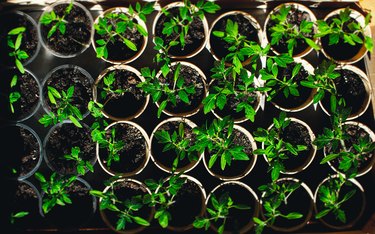
It's relaxing to watch natural rain on tomato plants, especially if it means that your plants may not need to be manually watered for a day or two. However, in some cases, rain on tomato plants may cause more harm than good. If your tomatoes are in pots or containers, you should consider bringing them under cover during the rain, but you don't always need to do so. If you can judge how your tomato plants are doing, you should know whether you need to bring them inside or if you can let them enjoy the rainfall where they are.
The Best Way to Water Tomatoes
Video of the Day
The best way to water tomato plants is to water slowly at the plant's lowest level. The best watering systems use trickle or soaker hoses to deliver water to the base of the plant and water at a slow rate for long periods so that the water can penetrate the soil.
Video of the Day
Water that comes in too fast won't fully penetrate the soil. This means that some of the deeper roots won't see any water. This rush of water can also carry away valuable nutrients and minerals in the soil due to overflow.
Rainfall or mist that lands on the tomato plant's leaves serves little purpose; it will either evaporate too quickly to be of any benefit or will remain long enough to attract pests and fungi. Slow, deep watering focused at the base of the plant (and a radius of about a foot extending from the base) is the best approach.
Dangers of Overwatering
Root rot is one of the biggest dangers that accompany overwatering. This occurs when soil remains wet for too long, and the plant's roots can't get enough oxygen. When roots start rotting, the plant's ability to feed itself begins to fail, and it loses structural integrity.
In addition to this, heavy watering or rainfall washes away fertilizer and the nutrients the plant needs to grow. Once tomatoes start to fruit, overwatering can split the fruit's skin, which allows pests and mold to reach the tomato's tender inside.
Judging the Rain on Tomato Plants
Tomato plants can withstand rainfall if the soil in which they are planted has good drainage capacity. Those that have good drainage will be able to absorb rainwater into the soil to feed the roots and flush away excess water. Gardens or containers that don't have suitable drainage will end up with tomato plants in the middle of soggy puddles. No matter how good the soil's drainage, hard and heavy rainfall can present a danger to any established garden.
Are tomato plants OK in the rain? That depends on your normal watering schedule, the age of the plant and how much rain you've had recently. Seedlings and newly transplanted tomatoes need a good amount of water delivered low, slow and deep, whereas older, established plants don't always need as much.
If you're in the middle of a wet spell, it may be a good idea to provide your tomatoes with some cover. If you've had a drought, the plants will probably appreciate the rainfall. If you water on a timer regularly, you may need to change your own watering schedule to compensate for an unexpected rainstorm.
- Savvy Gardening: How Often Do You Water Tomato Plants: In Gardens, Pots and Straw Bales
- The Ohio State University: Keeping Tomatoes Healthy in Wet Weathe
- Ohio State University Growing Cucumbers...; Pamela J. Bennett
- University of Illinois Extension; Growing Tomatoes; Maurice Ogutu; 2009
- University of Illinois Extension: Illinois Vegetable Garden Guide: Tomatoes